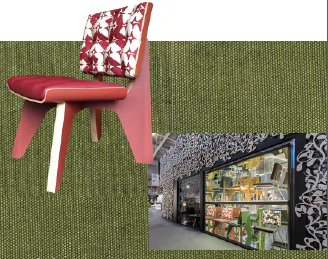This little red dot just got a lot brighter, with home-grown architectural firm WOHA named Designer of the Year Asia at the recent biannual edition of the Maison & Objet home fair in Paris. It seized the occasion to debut its new design brand, WOHAbeing, on the international design circuit.


This little red dot just got a lot brighter, with home-grown architectural firm WOHA named Designer of the Year Asia at the recent biannual edition of the Maison & Objet home fair in Paris. It seized the occasion to debut its new design brand, WOHAbeing, on the international design circuit

"THE ESSENCE AND SPIRIT OF WOHABEING COMES DOWN TO THREE THINGS: CREATING DELIGHT, BEING THOUGHTFUL AND BEING MEANINGFUL."

Working as architects, master planners, interior decorators and product designers, Singapore-based architectural agency WOHA has become a household name since it was founded by Wong Mun Summ and Richard Hassell in 1994. Its built projects, ranging from apartment towers and luxury resorts, to mass-transit stations and educational institutions across the Asia-Pacific region include the Parkroyal on Pickering hotel and office, Oasia Hotel Downtown, School of the Arts, Church of St. Mary of the Angels and The Met Bangkok apartments.

The Turtle chair features flipperlike legs inspired by its namesake.
WOHA’s eyecatching booth at the Maison & Objet fair.


Diaspora ceramic collection produced by Luzerne.

While working on various schemes over the years, the duo often couldn’t find furniture that reflected the building’s design concept and the regional climate and lifestyle, so they ended up designing the furniture and accessories themselves. This eventually led to increasing numbers of requests from the people who used these objects – often guests at their hospitality projects – to purchase a chair or table. After receiving news that they would be conferred the Maison&Objet Paris Designer of the Year Asia award last September and be given the opportunity to showcase their designs at the fair, they finally decided to take this part of their business into high gear.
Mun Summ and Richard launched their new design brand, WOHAbeing, at Maison & Objet Paris, unveiling six collections comprising 39 items of furniture, lighting, rugs, tableware and bathware, which were developed with five partners. Four of them are headquartered in Singapore – Apaiser bathroom specialists, Industry+ dedicated to producing contemporary design products by Asian creatives, fine china brand Luzerne, and The Rug Maker manufacturing bespoke carpets and rugs – while lighting company Wonder Glass is based in London. Designing for a broad audience, the architects were influenced by the places and cultures they hold dear, and each collection showcases a unique personality.
Richard says: “For us, the essence and spirit of WOHAbeing comes down to three things: Creating delight, being thoughtful and being meaningful. We want our pieces to put a smile on someone’s face, to be a delightful addition to their space, something that gives people a good feeling when they see it and use it. Thoughtfulness is something that applies to all aspects of our objects: The way they are designed to be not just aesthetically pleasing, but also comfortable, of high quality and durable, and the way they are made from sustainable materials by craftsmen in safe working conditions. Our pieces mean something to us, to the makers that use their craft to produce them, and they find meaning when they enter people’s lives and become a part of their homes.”
The rustic, playful and refined Bintan collection, inspired by the island of the same name where WOHA is designing a resort, features the Turtle chair with distinctive flipper-like legs available in six different colours and three versions – dining chair, easy chair and lounge chair – which may be combined with an ottoman, and the Crab series that stands on skinny, splayed metal legs.
Originally designed for the Alila Villas Uluwatu resort in Bali and adapted for WOHAbeing, the Ulu collection of indoor and outdoor furniture and lamps, with cast stoneware made in Vietnam by Industry+, echoes the Bukit in Bali, a wild landscape of cliffs and rugged savannah. A highlight is the imposing Ulu Centric round dining table with an integrated Lazy Susan, whose concentric ring motif resembles a giant tree slice.




WOHA worked with several local manufacturers to produce its designs, such as these rugs made by The Rug Maker.
Apaiser’s Sampan bathware assumes the shapes of origami paper boats.

Named after the Sanskrit word for the “glow of a lamp”, the Oli collection made in collaboration with Wonder Glass, experts in time-honoured Venetian glass-blowing, was inspired by ancient Hindu and Buddhist sacred geometry and architecture, and consists of a contemporary modular lighting system in hand-blown glass and bronze that comes in single lamp or chandelier versions. As Singapore is a trading port, the Sampan bathware created with Apaiser in Indonesia transposes the elegant, tapered shapes of traditional small river vessels to bright white bathtubs and vanities recalling origami paper boats.
Manufactured by The Rug Maker, the Corak collection of handmade rugs (limited to 15 pieces of each design) draws on Asia’s rich history in textiles and patterns, nature and new geometries, such as fractals and aperiodic tiling. A favourite of Hassell’s is the Lautan Rug, which is “complex and simple at the same time, gestural and ordered, and it has the quality of being inbetween two states. It is visually engaging and keeps your interest for a long time.” Inspired by the millions of Chinese people who have migrated to other regions for centuries, the Diaspora collection of convex and concave teacups, saucers and teapots crafted by Luzerne in China will also be shown this month at an exhibition at the National Design Centre in Singapore.
Mun Summ and Richard may take a similar approach to their architectural and furniture projects, but because many of their objects are tied to the schemes that they design, they often go from a large scale (architecture) to a smaller scale (interiors), and their furniture is therefore a natural extension of that process.


text Y-JEAN MUN-DELSALLE photos WOHA























